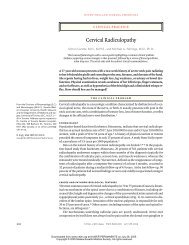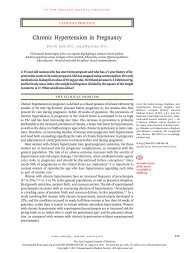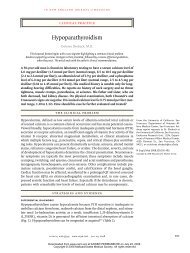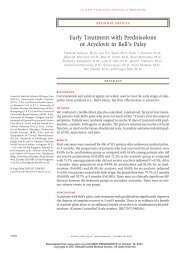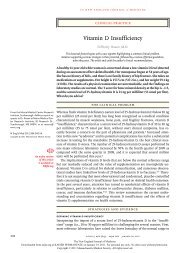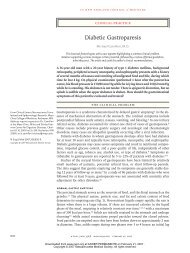Contrast-induced nephropathy: How it develops, how to prevent it
Contrast-induced nephropathy: How it develops, how to prevent it
Contrast-induced nephropathy: How it develops, how to prevent it
You also want an ePaper? Increase the reach of your titles
YUMPU automatically turns print PDFs into web optimized ePapers that Google loves.
CONTRAST-INDUCED NEPHROPATHY<br />
RUDNICK AND COLLEAGUES<br />
Low-osmolar<br />
agents have<br />
become the<br />
standard<br />
in <strong>prevent</strong>ing contrast-<strong>induced</strong> <strong>nephropathy</strong><br />
remains controversial.<br />
Theophylline:<br />
Not recommended at this time<br />
Several reports suggest that theophylline, an<br />
adenosine antagonist, <strong>prevent</strong>s contrast<strong>induced</strong><br />
<strong>nephropathy</strong>. 22,48<br />
Erley et al 48 randomized 39 patients who<br />
received contrast media <strong>to</strong> receive e<strong>it</strong>her intravenous<br />
theophylline or placebo. Although no<br />
patient in e<strong>it</strong>her group developed contrast<strong>induced</strong><br />
<strong>nephropathy</strong>, the glomerular filtration<br />
rate decreased in the placebo group from 88<br />
mL/minute at baseline <strong>to</strong> 75 mL/minute 4<br />
hours after contrast administration; <strong>it</strong> remained<br />
unchanged in the theophylline group.<br />
In several other placebo-controlled studies,<br />
theophylline (given orally or intravenously)<br />
<strong>prevent</strong>ed contrast-<strong>induced</strong> falls in creatinine<br />
clearance, but all the studies were in lowrisk<br />
patients, and contrast-<strong>induced</strong> <strong>nephropathy</strong><br />
was not seen in any groups.<br />
Theophylline has potential risks, including<br />
ventricular arrhythmias, seizures, and<br />
shock—all of which may be potentiated by a<br />
variety of other drugs. 22<br />
Conclusions. The data regarding theophylline<br />
are mixed. Favorable studies were<br />
lim<strong>it</strong>ed by small numbers, absence of high-risk<br />
patients, and a failure <strong>to</strong> demonstrate differences<br />
in the incidence of contrast-<strong>induced</strong><br />
<strong>nephropathy</strong>. Therefore, theophylline cannot<br />
be recommended as standard prophylaxis<br />
against contrast-<strong>induced</strong> <strong>nephropathy</strong> at this<br />
time.<br />
Low-osmolar agents<br />
are better than high osmolar agents<br />
Introduced in the 1980s, nonionic low-osmolar<br />
contrast agents have replaced ionic highosmolar<br />
agents as the standard intravascular<br />
contrast media because of their lower incidence<br />
of adverse effects. 3<br />
Studies in animals have demonstrated<br />
that, compared w<strong>it</strong>h high-osmolar agents,<br />
low-osmolar agents result in less nephro<strong>to</strong>xic<strong>it</strong>y<br />
but still can cause <strong>nephropathy</strong>. 8 In<strong>it</strong>ial<br />
clinical studies comparing high-osmolar vs<br />
low-osmolar contrast agents failed <strong>to</strong> demonstrate<br />
a difference between these two types of<br />
agents but were underpowered in respect <strong>to</strong><br />
high-risk azotemic patients. 8<br />
In 1995, Rudnick et al 11 performed a<br />
prospective, randomized, double-blind study<br />
comparing the high-osmolar contrast agent diatrizoate<br />
w<strong>it</strong>h the low-osmolar contrast agent<br />
iohexol in 1,196 patients, including 509<br />
azotemic patients, of whom 213 had diabetes.<br />
In patients w<strong>it</strong>hout azotemia, the incidence of<br />
contrast-<strong>induced</strong> <strong>nephropathy</strong> was negligible<br />
w<strong>it</strong>h e<strong>it</strong>her agent, regardless of whether or not<br />
the patient had diabetes. <strong>How</strong>ever, in patients<br />
w<strong>it</strong>h azotemia but w<strong>it</strong>hout diabetes, the incidence<br />
of contrast-<strong>induced</strong> <strong>nephropathy</strong> was 7%<br />
w<strong>it</strong>h the high-osmolar agent vs 4% w<strong>it</strong>h the<br />
low-osmolar agent. In patients w<strong>it</strong>h azotemia<br />
and diabetes, the differences were even more<br />
pronounced: 27% w<strong>it</strong>h the high- osmolar agent<br />
and 12% w<strong>it</strong>h the low-osmolar agent.<br />
A subsequent meta-analysis indicated that<br />
low-osmolar agents reduced the incidence of<br />
contrast-<strong>induced</strong> <strong>nephropathy</strong> by 50%. 23<br />
Are iso-osmolar agents<br />
better than low-osmolar agents?<br />
The iso-osmolar contrast agents have undergone<br />
experimental and clinical studies comparing<br />
their nephro<strong>to</strong>xic<strong>it</strong>y w<strong>it</strong>h that of the<br />
currently popular low-osmolar agents. As discussed<br />
above, these third-generation agents<br />
have not demonstrated less nephro<strong>to</strong>xic<strong>it</strong>y<br />
than low-osmolar agents in studies in animals.<br />
Furthermore, only a few clinical studies have<br />
compared the incidence of contrast-<strong>induced</strong><br />
<strong>nephropathy</strong> w<strong>it</strong>h the two types of agents. 24,49<br />
Aspelin et al 24 performed a prospective,<br />
randomized, double-blind, multicenter trial in<br />
129 patients w<strong>it</strong>h azotemia and diabetes.<br />
Patients were randomly assigned <strong>to</strong> receive<br />
e<strong>it</strong>her iohexol (a low-osmolar agent) or iodixanol<br />
(an iso-osmolar agent). The incidence of<br />
contrast-<strong>induced</strong> <strong>nephropathy</strong> was 3% w<strong>it</strong>h<br />
the iso-osmolar agent vs 26% w<strong>it</strong>h the lowosmolar<br />
agent (odds ratio 0.09, P = .002).<br />
Larger randomized trials will be needed <strong>to</strong><br />
verify these encouraging results, especially<br />
w<strong>it</strong>h comparisons <strong>to</strong> other low-osmolar contrast<br />
agents.<br />
Hemodialysis and hemofiltration<br />
Numerous studies have demonstrated that 2 <strong>to</strong><br />
3 hours of hemodialysis effectively removes<br />
60% <strong>to</strong> 90% of contrast medium. 50 Several<br />
84 CLEVELAND CLINIC JOURNAL OF MEDICINE VOLUME 73 • NUMBER 1 JANUARY 2006






